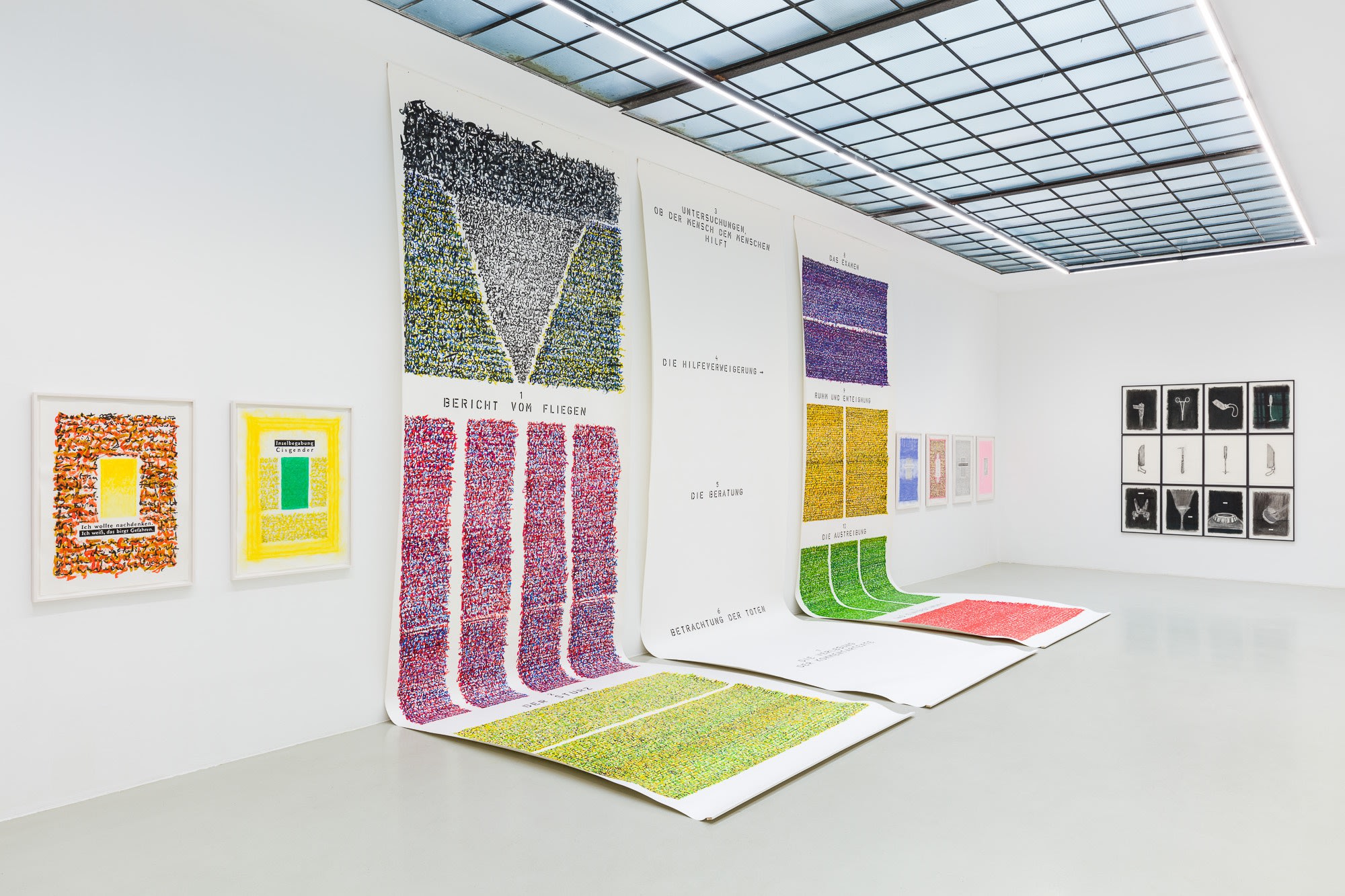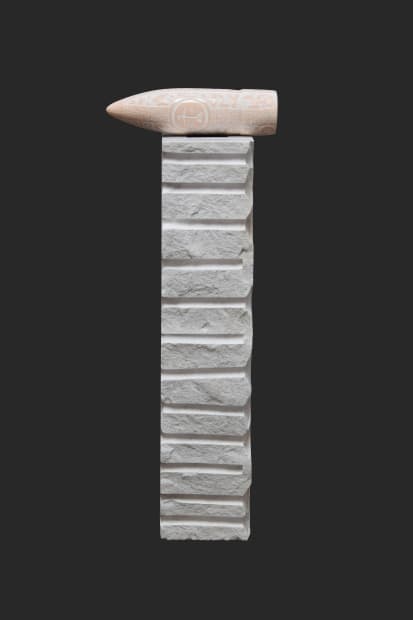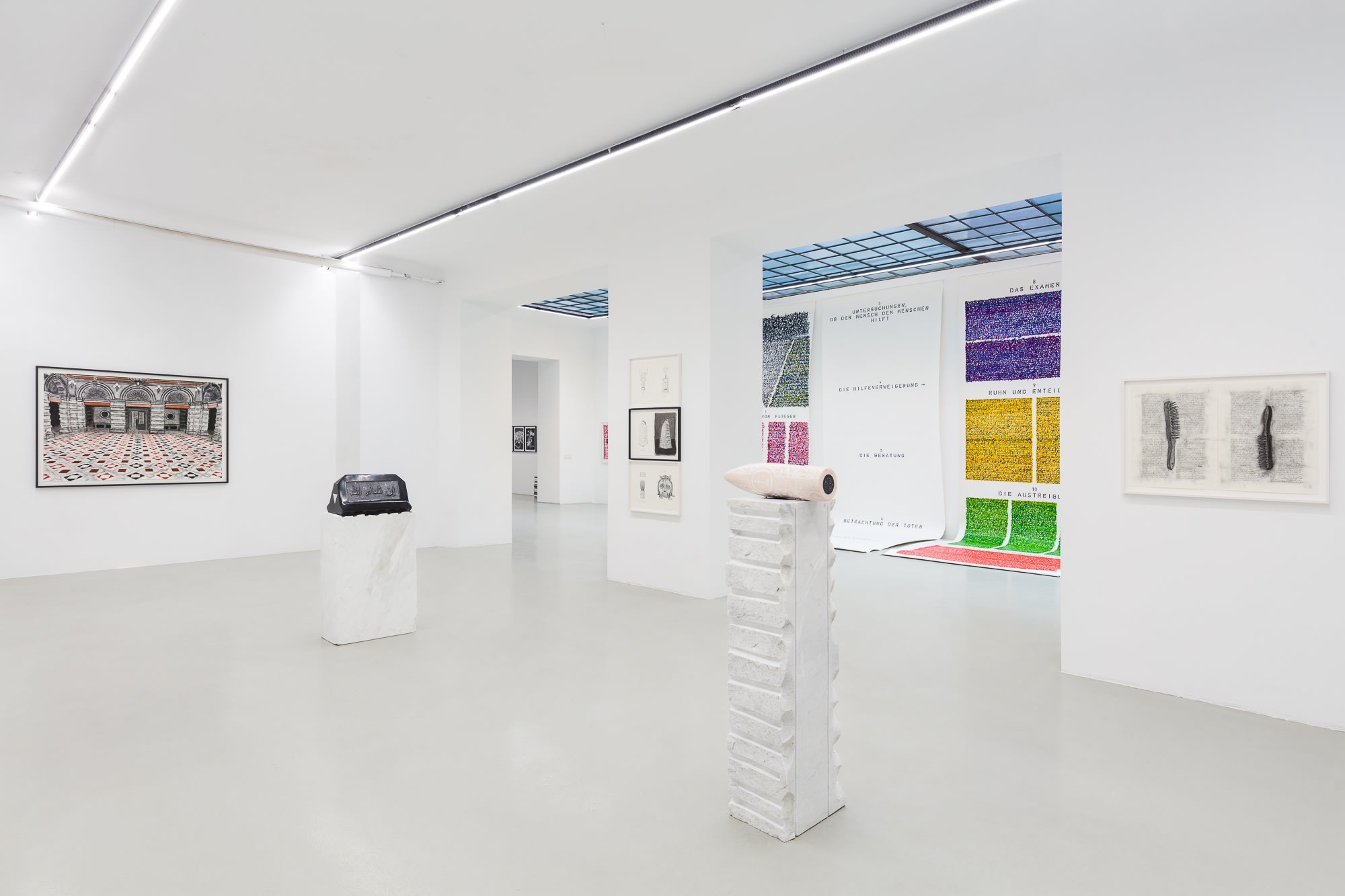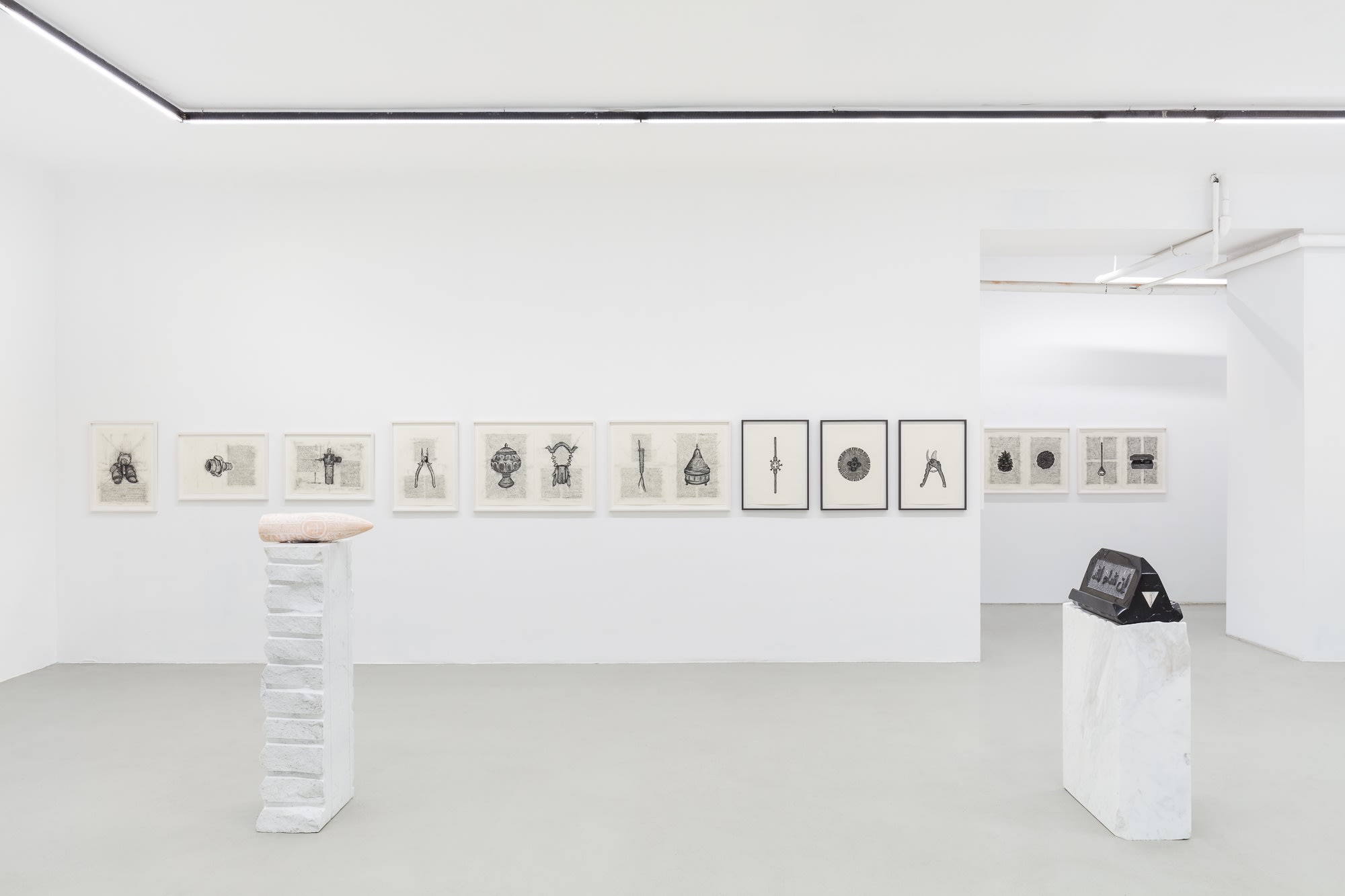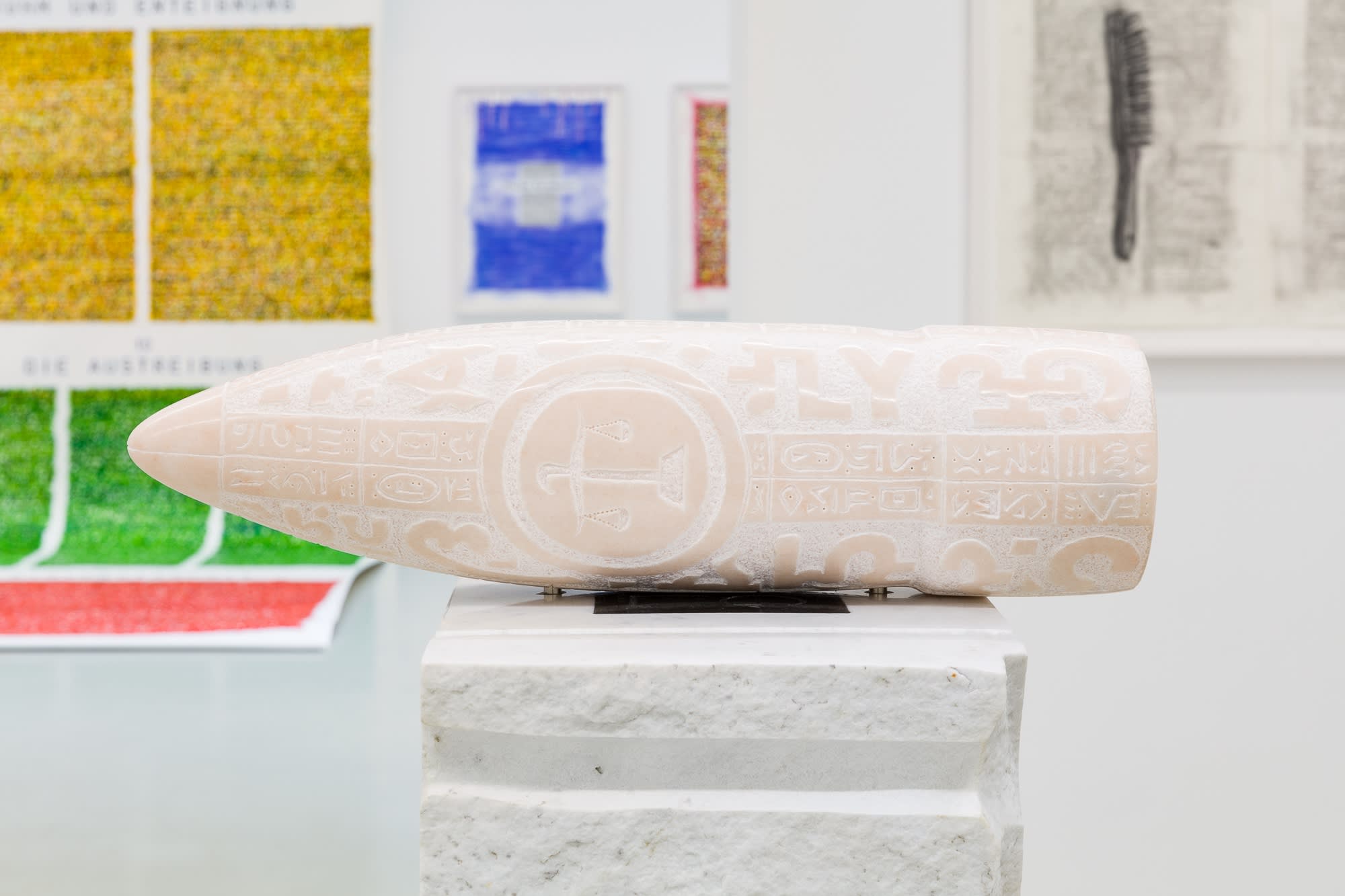-
MARKUS REDL
FLUSSMITTE -
The title of the exhibition ‘FLUSSMITTE’ refers to the art book ‘Flussmitte Porträts der Dinge’ which was recently published by Markus Redl. It contains drawings made over five years (2015-2020). A large part of these drawings originates from the period of the first two lockdowns in 2020, during the pandemic of CoVID19 and its aftermath. They are documents of the time, and a journey in a confined space; one's own living space and the way to the grocery store, combined with texts, through which another journey takes place, without much spatial movement. In these cycles of drawings language, text, space are compressed, layered on top of and within each other.
-
 Installation View, Markus Redl, Flussmitte, 2021
Installation View, Markus Redl, Flussmitte, 2021 -
 Installation View, Markus Redl, Flussmitte, 2021
Installation View, Markus Redl, Flussmitte, 2021 -

Installtion View, Markus Redl, Flussmitte, 2021 showing Brecht Zyklus I & II
-
BRECHT ZYKLUS I
For the Brecht-Zyklus II), the Baden-Baden Lesson on Consent was rewritten several times. Colours were assigned to the actors’ voices, and the threads of their statements, in the form of lines, words written with a brush, were laid in and on top of each other, were linked, and gradually structured an area that increasingly turned structureless. In Brecht's Lehrstück (didactic drama), a few outstanding members o the community, the aviators, flew higher than anybody else. They have moved away from the community and then crashed to the ground. Now, the community has to decide whether to help them, since the crashed aviators ask for their help. The community negotiates and decides not to help. The value of the
individual and the value of the community cannot be merged without friction and cannot easily be adapted to one another.
-
"
Reverse_renewal and
The past is unpredictable
Things remain as they become
Freak Out Have a Rest Freak OutDisagreement leads to the system of
The majority vote
Impeachable victimhood
Flat learning curveWe still must tear out the grass
To keep it green
Yesterday today tomorrowNothing from me
Stolen everything
" -
 Markus Redl, Der Schopenhauer-Zyklus II, 2020, 12 sheets, ink, pencil, charcoal, typewritter, paper, 42 x 59 cm (16 1/2 x 23 1/4 in) total installation approx. 210 x 220 cm
Markus Redl, Der Schopenhauer-Zyklus II, 2020, 12 sheets, ink, pencil, charcoal, typewritter, paper, 42 x 59 cm (16 1/2 x 23 1/4 in) total installation approx. 210 x 220 cm -
 Installation View, Markus Redl, Flussmitte, 2021
Installation View, Markus Redl, Flussmitte, 2021 -
 Markus RedlStein 156–157 [Wendemittel] , 2021Bianco Carrara Marmor, Nero Belgio, Rosa Portogallo145 x 50 x 40 cm
Markus RedlStein 156–157 [Wendemittel] , 2021Bianco Carrara Marmor, Nero Belgio, Rosa Portogallo145 x 50 x 40 cm
57 1/8 x 19 3/4 x 15 3/4 in -
 Installation View, Markus Redl, Flussmitte, 2021
Installation View, Markus Redl, Flussmitte, 2021 -
 Markus RedlStein 159-160 [Wendemittel II], 2021Bianco Carrara marble, Nero Belgio, Rosa Aurora120 x 60 x 30 cm
Markus RedlStein 159-160 [Wendemittel II], 2021Bianco Carrara marble, Nero Belgio, Rosa Aurora120 x 60 x 30 cm
47 1/4 x 23 5/8 x 11 3/4 in -
 Installation View, Markus Redl, Flussmitte, 2021
Installation View, Markus Redl, Flussmitte, 2021 -

Markus Redl, Brecht-Zyklus II,
3 sheets of paper board (2.2 x 6.6 m),
ink on paper, glued to wooden slats
-
 Markus Redl, Stein 156–157 [Wendemittel] , 2021, Bianco Carrara Marmor, Nero Belgio, Rosa Portogallo, 145 x 50 x 40 cm 57, 1/8 x 19 3/4 x 15 3/4 in
Markus Redl, Stein 156–157 [Wendemittel] , 2021, Bianco Carrara Marmor, Nero Belgio, Rosa Portogallo, 145 x 50 x 40 cm 57, 1/8 x 19 3/4 x 15 3/4 in -
SELECTED EXHIBITIONS OF THE ARTIST
Recent solo exhibitions include 'Mudras', Galerie Kandlhofer, 2017; ‘Betrachtungen – Arbeiten aus 10 Jahren', Galerie Chobot, 2015 and 'Markus Redl. Vogelfrei', Galerie Kandlhofer, 2015. Group exhibitions include: Würth Sculpture Garden, Schloss Arenberg, Salzburg, AT 2021; 'Ich bin alles zugleich' Lan-desgalerie Niederösterreich, Krems, AT 2019; 'Menagerie‘, Forum Würth, Rorschack, 2017; 'A.E.I.O.U.', Art Forum Würth, Capena, 2017; 'Endurance', Galerie Kandlhofer, 2016; 'Der Erzherzogshut / 400 Jahre Krone für Österreich', Stiftsmuseum Klosterneuburg, AT 2016; 'Skulpturen im Park' Schloss Halbturn, Burgenland, AT 2015; 'Von Hockney bis Holbein Die Sammlung Würth in Berlin', Martin-Gropius-Bau, Berlin, 2015; 'Menagerie / Tierschau aus der Sammlung Würth', Kunsthalle Würth, Schwäbisch Hall, DE 2013; ‚Wo die Kunst sich sammelt’, Museum Anger-lehner, AT 2013.
MARKUS REDL: FLUSSMITTE
Past viewing_room


